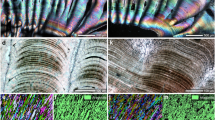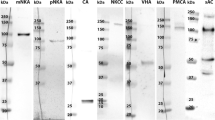Abstract
The fish otolith consists mainly of calcium carbonate and organic matrices, the latter of which may play important roles in the process of otolith formation. We previously identified two otolith matrix proteins, named otolith matrix protein-1 (OMP-1) and otolin-1, from the rainbow trout, Oncorhynchus mykiss, and the chum salmon, O. keta. In this study, recombinant proteins corresponding to OMP-1 and otolin-1 were synthesized using yeast and bacterial expression systems, respectively, to produce specific antibodies against each protein. Immunohistochemical analysis using these antisera revealed that in the otoliths of adult fish, OMP-1 and otolin-1 were colocalized along the daily rings possibly formed by alternate deposition of calcium carbonate and organic matrices. In the adult inner ear, OMP-1 was produced at most of the saccular epithelium, while otolin-1 was produced at a limited part of cylindrical cells located at the marginal zone of the sensory epithelium. In the embryonic inner ear, these proteins had already existed in the otolith primordia when calcification had commenced. In addition, otolin-1 was localized in the fibrous materials connecting otolith primordia and sensory epithelium at this stage. These results indicate that these proteins are required as essential components for otolith formation and calcification.







Similar content being viewed by others
References
Aisen P, Leibman A (1972) Lactoferrin and transferrin: a comparative study. Biochim Biophys Acta 257:314–323
Arias JL, Fernandez MS, Dennis JE, Caplan AI (1991) Collagens of the chicken eggshell membrane. Connect Tissue Res 26:37–45
Baba K, Shimizu M, Mugiya Y, Yamada J (1991) Otolith matrix proteins of walleye pollock: biochemical properties and immunohistochemical localization in the saccular tissue. In: Suga S, Nakahara H (eds) Mechanisms and phylogeny of mineralization in biological systems. Springer, Tokyo, pp 57–61
Brothers EB, Mathews CP, Lasker R (1976) Daily growth increments in otoliths from larval and adult fishes. Fish Bull 74:1–8
Campana SE, Neilson JD (1985) Microstructure of fish otoliths. Can J Fish Aquat Sci 42:1014–1032
Dunkelberger DG, Dean JM, Watabe N (1980) The ultrastructure of the otolithic membrane and otolith in the juvenile mummichog, Fundulus heteroclitus. J Morphol 163:367–377
Eyre DR (1980) Collagen: molecular diversity in the body’s protein scaffold. Science 207:1315–1322
Fay RR (1980) The goldfish ear codes the axis of acoustic particle rotation in three dimensions. Science 225:951–953
Gauldie, RW, Nelson DGA (1990) Otolith growth in fishes. Comp Biochem Physiol 97A:119–135
Hsu SM, Raine L, Fanger H (1981) Use of avidin-biotin-peroxidase complex (ABC) in immunoperoxidase techniques: a comparison between ABC and unlabeled antibody (PAP) procedures. J Histochem Cytochem 29:577–580
Laemmli UK (1970) Cleavage of structural proteins during the assembly of the head of bacteriophage T-4. Nature 227:680–685
Lowenstein O (1971) The labyrinth. In: Hoar WS, Randall DJ (eds) Fish physiology, vol V. Sensory system and electric organs. Academic, New York, pp 207–240
Luna LG (1968) Manual of histologic staining methods of the Armed Forces Institute of Pathology, 3rd edn. McGraw-Hill, New York, p 258
Manning FB (1924) Hearing in the goldfish in relation to the structure of its ear. J Exp Zool 41:5–20
Mugiya Y (1974) Calcium-45 behavior at the level of the otolithic organs of rainbow trout. Bull Jpn Soc Sci Fish 34:1096–1106
Mugiya Y (1987) Phase difference between calcification and organic matrix formation in the diurnal growth of otoliths in the rainbow trout, Salmo gairdneri. Fish Bull 85:395–401
Murayama E, Okuno A, Ohira T, Takagi Y, Nagasawa H (2000) Molecular cloning and expression of an otolith matrix protein cDNA from the rainbow trout, Oncorhynchus mykiss. Comp Biochem Physiol 126B:511–520
Murayama E, Takagi Y, Ohira T, Davis JG, Greene MI, Nagasawa H (2002) Fish otolith contains a unique structural protein, otolin-1. Eur J Biochem 269:688–696
Neilson JD, Green GH, Chan B (1985) Variability in dimensions of salmonid otolith nuclei: implications for stock identification and microstructure interpretation. Fish Bull 83:81–89
Pisam M, Payan P, LeMoal C, Edeyer A, Boeuf G, Mayer-Gostan N (1998) Ultrastructural study of the saccular epithelium of the inner ear of two teleosts, Oncorhynchus mykiss and Psetta maxima. Cell Tissue Res 294:261–270
Pisam M, Jammet C, Laurent D (2002) First steps of otolith formation of the zebrafish: role of glycogen? Cell Tissue Res 310:163–168
Radtke RL, Dean JM (1982) Increment formation in the otoliths of embryos, larvae, and juveniles of the mummichog, Fundulus heteroclitus. Fish Bull 80:201–215
Saito S, Yamada J (1989) Ultrastructure of the saccular epithelium and the otolithic membrane in relation to otolith growth in tilapia, Oreochromis niloticus (Teleostei: Cichlidae). Trans Am Microsc Soc 108:223–238
Scott JE, Kyffin TW (1978) Demineralization on organic solvents by alkylammonium salts of ethylenediaminetetraacetic acid. Biochem J 169:697–710
Sokolowski BHA (1986) Development of the otolith in embryonic fishes with special reference to the toad fish, Opsanus tau. Scan Electron Microsc 4:1635–1648
Takagi Y (1997) Meshwork arrangement of mitochondria-rich, Na+,K+-ATPase-rich cells in the saccular epithelium of rainbow trout (Oncorhynchus mykiss) inner ear. Anat Rec 248:483–489
Takagi Y, Takahashi A (1999) Characterization of otolith soluble-matrix producing cells in the saccular epithelium of rainbow trout (Oncorhynchus mykiss) inner ear. Anat Rec 254:322–329
Watabe N, Tanaka K, Yamada J, Dean JM (1982) Scanning electron microscope observations of the organic matrix in the otolith of the teleost fish Fundulus heteroclitus and Tilapia nilotica. J Exp Mar Biol Ecol 58:127–134
Woodbury RG, Brown JP, Yeh MY, Hellström I, Hellström KE (1980) Identification of a cell surface protein, p97, in human melanomas and certain other neoplasms. Proc Natl Acad Sci U S A 77:2183–2187
Zhang Z, Runham NW (1989) Initial development of Oreochromis niloticus (Teleostei: Cichlidae) otolith. J Zool Lond 227:465–478
Acknowledgements
We are grateful to Dr. Goro Yoshizaki and Dr. Yutaka Takeuchi of the Department of Aquatic Biosciences, Tokyo University of Fisheries, for their generous gift of rainbow trout embryos and valuable discussion concerning embryonic development. We also thank Dr. M.N. Wilder of the Japan International Research Center for Agricultural Sciences for critical reading of the manuscript. This work was supported by Grants-in-Aid for Creative Basic Research (number 12NP0201) and for Scientific Research (numbers 12876025, 13660176, and 13660178) from the Ministry of Education, Culture, Sports, Science and Technology of Japan. The first author (E.M.) was supported by a Research Fellowship of the Japan Society for the Promotion of Science for Young Scientists.
Author information
Authors and Affiliations
Corresponding author
Rights and permissions
About this article
Cite this article
Murayama, E., Takagi, Y. & Nagasawa, H. Immunohistochemical localization of two otolith matrix proteins in the otolith and inner ear of the rainbow trout, Oncorhynchus mykiss: comparative aspects between the adult inner ear and embryonic otocysts. Histochem Cell Biol 121, 155–166 (2004). https://doi.org/10.1007/s00418-003-0605-5
Accepted:
Published:
Issue Date:
DOI: https://doi.org/10.1007/s00418-003-0605-5




